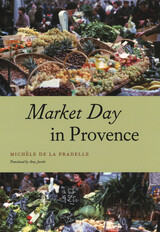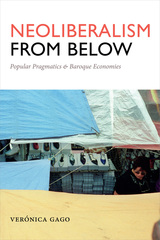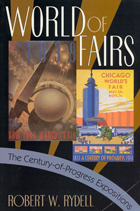4 books about Fairs

Market Day in Provence
Michèle de La Pradelle
University of Chicago Press, 2006
At farmers’ markets, we expect to see fruit bursting with juicy sweetness and vegetables greener than a golf course. For Michèle de La Pradelle these expectations are mostly the result of a show performed by merchants and sustained by our propensity to see what we want to see there. Hailed upon its release in France, the award-winning Market Day in Provence lays bare the mechanisms of the contemporary outdoor market by providing a definitive account of the centuries-old institution at Carpentras, a city near Avignon in the south of France famous for its quintessential public street market.
The renewal and celebration of the outdoor market culture in recent years, argues de La Pradelle, artfully masks a fierce commitment to modern-day free-market economics. Responding to consumer desire for an experience that recalls a time before impersonal supermarket chains and mass-produced products, buyers and sellers alike create an atmosphere built on various fictions. Vendors at the market at Carpentras, for example, oblige patrons by acting like lifelong acquaintances of those whom they’ve only just met as they dispense free samples and lively, witty banter. Likewise, going to the market to look for “freshness” becomes a way for the consumer to signify the product’s relation to nature—a denial of the workaday reality of growing melons under plastic sheets, then machine-sorting, crating, and transporting them.
Offering captivating descriptions of goods and the friendly and occasionally piquant exchanges between buyers and sellers, Market Day in Provence will be devoured by any reader with an interest in areas as diverse as food, ethnography, globalization, modernity, and French culture.
The renewal and celebration of the outdoor market culture in recent years, argues de La Pradelle, artfully masks a fierce commitment to modern-day free-market economics. Responding to consumer desire for an experience that recalls a time before impersonal supermarket chains and mass-produced products, buyers and sellers alike create an atmosphere built on various fictions. Vendors at the market at Carpentras, for example, oblige patrons by acting like lifelong acquaintances of those whom they’ve only just met as they dispense free samples and lively, witty banter. Likewise, going to the market to look for “freshness” becomes a way for the consumer to signify the product’s relation to nature—a denial of the workaday reality of growing melons under plastic sheets, then machine-sorting, crating, and transporting them.
Offering captivating descriptions of goods and the friendly and occasionally piquant exchanges between buyers and sellers, Market Day in Provence will be devoured by any reader with an interest in areas as diverse as food, ethnography, globalization, modernity, and French culture.
[more]

Meet Me on the Midway
A History of Wisconsin Fairs
Jerry Apps
Wisconsin Historical Society Press, 2022
Jerry Apps explores the history of county and state fairs in Wisconsin, from their earliest incarnations as livestock exhibitions to today’s multitude of exhibits and demonstrations, grandstand entertainment, games and rides, and competitions of all sorts. Drawing on his extensive research, interviews, and personal experience as a 4-H leader, county extension agent, fair judge, and lifelong fairgoer, Apps takes readers back through 178 years of Wisconsin fair history, covering everything from horsepulling and calf-showing contests to exhibit judging to the roar of gasoline engines powering the midway rides. He evokes the sights and sounds of fairs through the ages while digging in to the political and social forces that shaped the fair into an icon of our rural heritage. Illustrated with vintage and modern photos and featuring the voices of exhibitors, judges, volunteers, and visitors, Meet Me on the Midway vividly captures the thrills and cherished memories of these beloved annual gatherings.
[more]

Neoliberalism from Below
Popular Pragmatics and Baroque Economies
Verónica Gago
Duke University Press, 2017
In Neoliberalism from Below—first published in Argentina in 2014—Verónica Gago examines how Latin American neoliberalism is propelled not just from above by international finance, corporations, and government, but also by the activities of migrant workers, vendors, sweatshop workers, and other marginalized groups. Using the massive illegal market La Salada in Buenos Aires as a point of departure, Gago shows how alternative economic practices, such as the sale of counterfeit goods produced in illegal textile factories, resist neoliberalism while simultaneously succumbing to its models of exploitative labor and production. Gago demonstrates how La Salada's economic dynamics mirror those found throughout urban Latin America. In so doing, she provides a new theory of neoliberalism and a nuanced view of the tense mix of calculation and freedom, obedience and resistance, individualism and community, and legality and illegality that fuels the increasingly powerful popular economies of the global South's large cities.
[more]

World of Fairs
The Century-of-Progress Expositions
Robert W. Rydell
University of Chicago Press, 1993
In the depths of the Great Depression, when America's future seemed bleak, nearly one hundred million people visited expositions celebrating the "century of progress." These fairs fired the national imagination and served as cultural icons on which Americans fixed their hopes for prosperity and power.
World of Fairs continues Robert W. Rydell's unique cultural history—begun in his acclaimed All the World's a Fair—this time focusing on the interwar exhibitions. He shows how the ideas of a few—particularly artists, architects, and scientists—were broadcast to millions, proclaiming the arrival of modern America—a new empire of abundance build on old foundations of inequality.
Rydell revisits several fairs, highlighting the 1926 Philadelphia Sesquicentennial, the 1931 Paris Colonial Exposition, the 1933-34 Chicago Century of Progress Exposition, the 1935-36 San Diego California Pacific Exposition, the 1936 Dallas Texas Centennial Exposition, the 1937 Cleveland Great Lakes and International Exposition, the 1939-40 San Francisco Golden Gate International Exposition, the 1939-40 New York World's Fair, and the 1958 Brussels Universal Exposition.
World of Fairs continues Robert W. Rydell's unique cultural history—begun in his acclaimed All the World's a Fair—this time focusing on the interwar exhibitions. He shows how the ideas of a few—particularly artists, architects, and scientists—were broadcast to millions, proclaiming the arrival of modern America—a new empire of abundance build on old foundations of inequality.
Rydell revisits several fairs, highlighting the 1926 Philadelphia Sesquicentennial, the 1931 Paris Colonial Exposition, the 1933-34 Chicago Century of Progress Exposition, the 1935-36 San Diego California Pacific Exposition, the 1936 Dallas Texas Centennial Exposition, the 1937 Cleveland Great Lakes and International Exposition, the 1939-40 San Francisco Golden Gate International Exposition, the 1939-40 New York World's Fair, and the 1958 Brussels Universal Exposition.
[more]
READERS
Browse our collection.
PUBLISHERS
See BiblioVault's publisher services.
STUDENT SERVICES
Files for college accessibility offices.
UChicago Accessibility Resources
home | accessibility | search | about | contact us
BiblioVault ® 2001 - 2024
The University of Chicago Press









